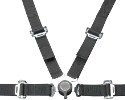 Question: I have a truck that the previous owner installed 4 point harness seat belts in. The previous owner drove the truck on the road regularly. I just want to see if the 4 point harness is legal to use or if I should swap them out for the stock seat belts.
Question: I have a truck that the previous owner installed 4 point harness seat belts in. The previous owner drove the truck on the road regularly. I just want to see if the 4 point harness is legal to use or if I should swap them out for the stock seat belts.
4 Point Harness Could be Legal
Your 4 point harness could be legal to use on the highway, if the person that installed it did everything right. As you will see, that might be a difficult task.
Standards for Seat Belts
Transport Canada sets the standards for the manufacture of vehicles and their equipment through the Motor Vehicle Safety Act and the Motor Vehicle Safety Regulations. There are two major concerns, the first being that the harness meets the MVSR standard for it's purpose and the second involves the anchor point where the harness attaches to the vehicle body.
There is also mention in the Superintendent's Standards (the inspection manual used by Designated Inspection Facilities):
Seat belts MUST comply with CMVSR 208 for year of vehicle manufacture.
Reject if:
-missing, not equipped as originally manufactured, broken, excessively frayed, torn webbing, warning indicator exposed, insecurely mounted, cut
– lap belts are not attached to the seat and not equipped with a secondary belt from the seat to the floor if equipped with air ride, hydraulic or spring seat
– compliance label missing
Enforcement of Standards
Enforcement of these standards falls to the provinces and this is what the Motor Vehicle Act has to say:
Seat belt assembly
220 (3) A person must not drive or operate a motor vehicle on a highway in which a seat belt assembly required under this section or the Motor Vehicle Safety Act (Canada) at the time the motor vehicle was manufactured, assembled or imported into Canada has been removed, rendered partly or wholly inoperative, or modified to reduce its effectiveness.
At this point, chances are good that you will run into trouble either at roadside with police or at a designated inspection facility as all of this points to nothing being acceptable but the seat belts originally installed by the manufacturer.
However, if you feel strongly about using the 4 point harness instead of the OEM seat belt, you might still be able to do it.
National Safety Mark
Find a secondary manufacturer that is authorized to affix the National Safety Mark and will do the necessary work. If they accept the job, they will insure that the harness is acceptable, installed properly and certify that it is so that you can justify your choice later on.
Chances are great that this was not done with the harness that you are asking about and you are correct to be concerned.
If the previous owner is not able to furnish proof that the harness is properly installed, you may have recourse against them for selling you a vehicle that did not meet standards:
Sale of motor vehicle contrary to regulations
222 A person must not sell, offer for sale, expose or display for sale or deliver over to a purchaser for use a motor vehicle, trailer or equipment for them that is not in accordance with this Act and the regulations.
The vendor may be able to escape this requirement by advising the potential purchaser that the vehicle does not meet standards and must not be driven on the road until it does. This would be wise to record on whatever written sales documents are exchanged at the time of purchase.
The Easy Answer
It looks like the easiest answer is to swap them for stock seat belts.
Seat Belts from an Auto Wrecker
A final caution, be very careful if you decide to buy a used seat belt for the replacement! You may have no way of knowing if the used belt will still function correctly and has not been involved in a collision already. In the case of pre-tensioners, this could mean that the belt would be less effective than a new one.
Share This Article
- Log in to post comments
